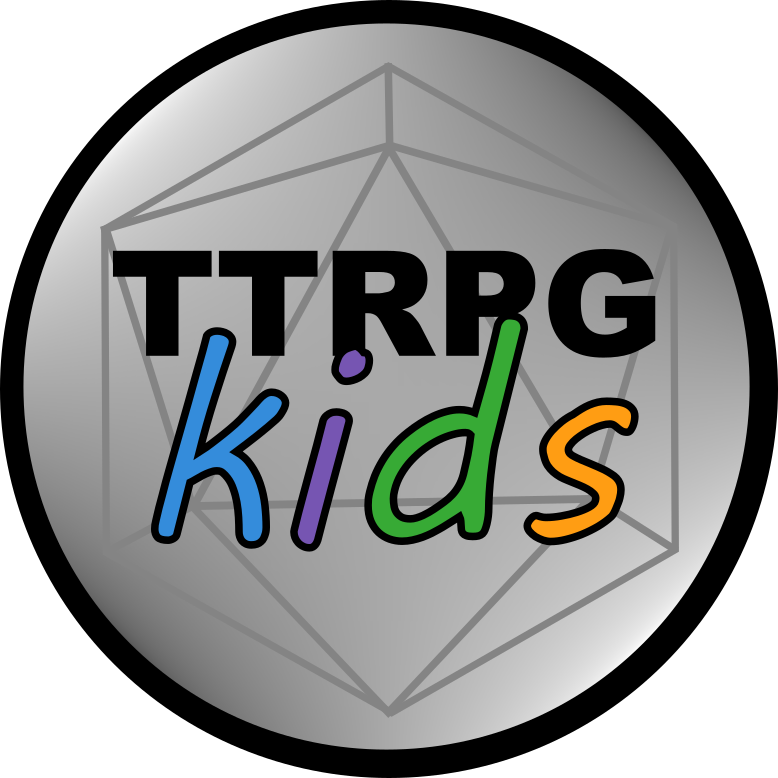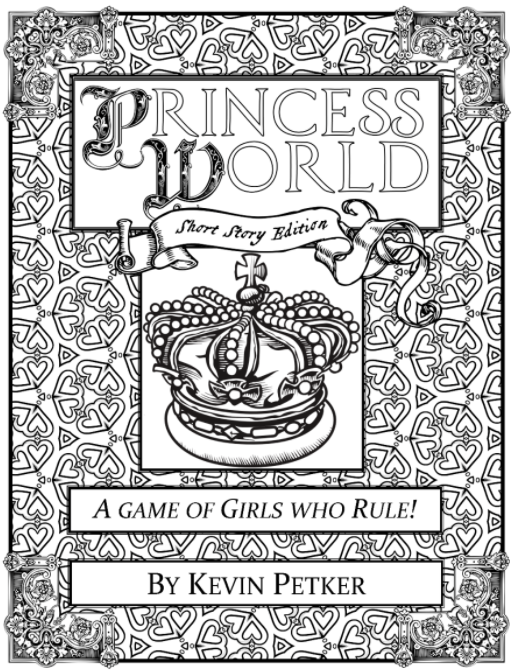TTRPGkids review: Princess World
Note: This post may contain affiliate links. At no additional cost to you, I may earn a small commission from purchases made using them. TTRPGkids uses this to keep the site going. Read full disclosure here.
Jump to:
Age target: 8+
Princess World is aimed at kids 8+ and seems pretty good for that age target. There’s a bit of reading, but not too much, there’s a good amount of social play and teamwork, and the vibes… this feels like the most recent She-Ra show (which is rated for 7+), and it’s amazing!
There’s adventure, action, teamwork, problem solving, and tons more – all great skills for kids to practice and get to play out from their favorite shows.
Setting:
Princess World is set in a general fantasy world that you get to tweak and create as a group (it isn’t just on the GM). The character books for the game include fairy princesses, pirate princesses, space princesses, and more, so the setting can be as varied as the characters’ backgrounds.
One part of Princess World that I REALLY liked was that it promotes getting suggestions from all the players in order to create the scene. Everyone suggests different plot elements at the beginning of the story, and then the Weaver ties them together. For example, one player may suggest that there’s been strange shadows seen at night while another player suggests that The Great Unicorn has stopped in a nearby field and the town is having a celebration, and another player says a spaceship has crash landed in the middle of the lake…. All of these create the world and the game for players to explore. Everyone gets to suggest something and have some say in the world being played.
Over-arching these elements, there’s still a general theme of the Princess Council running things and trying to maintain peace – they are also the reason you are out trying to help everyone. And… there’s they mysterious Fade out there creating trouble (more on this later). However, both of these are kind of like a general framework for the story, so you end up with A LOT of flexibility for the setting and making this game truly owned by the group.
Your character:
Princess World uses playbooks that make character creation SUPER easy – you choose which princess you want to play as and then fill in a few extra elements on the sheet and are ready to go! There’s no spending a whole session picking stats and abilities, it is already set up.
You pick out your favorite color (this is really important because all your notes are color-coded to you), your character’s name, and a few truths, moves, and threads (more on this later). The rest (your stats, thread prompts, etc) are already on the sheet and ready to go.
Despite it being mostly set up, you still have a ton of variety. In the core set, you get to pick between the following types of princesses: Proper, Pirate, Fairy, Space, Skateboard. There’s also four extra princess playbooks that were added on to include: Knight, Warrior, Shadow, Pauper.
Mechanics:
Stats and rolling:
Rolling for actions is pretty straight forward – when you want to do something significant, you roll 2d6 and add them. Then, you add or subtract any modifiers from your stats and threads. That final result is then compared to a table to see to what level you succeeded or if any complications are introduced (which drive the story forward even though they can cause trouble).
You have four stats to track: poise, pluck, persuade, and punch! These determine how well you can conduct yourself, fight, and figure out different situations together.
Threads:
I really liked that Princess World has a built-in mechanic for creating connections between all the players. This is done via something called “threads”.
Each princess has a few threads on their character sheet that are along the lines of “you find me annoying” or “you told me a surprising secret”. Players give these threads (which are on little signed slips of paper) to each other in order to form story-based connections and weave all the characters together. Then, throughout the game, these can be “tapped” or used to modify rolls, give help, etc.
I thought this was awesome both from a storytelling standpoint and from a teamwork standpoint! First, you don’t need a session zero to figure out how everyone knows each other, this already sets it up and creates those connections between each character. Second, this means that you have a mechanic that gets you to work together throughout the whole game! Players are constantly checking how they interact with each other and get to use that (so there incentive to RP together).
The Fade:
The Fade sounds a bit like the boogeyman of Princess World (and it very well could be in your particular story), but it’s basically an energy that is created by the players and then used by the Weaver (who is moderating the story)…. and I thought it was a really clever mechanic for creating some balanced chaos.
There’s a few ways it interacts with the story:
- Princesses can swap their stat modifiers by paying Blots of Fade to the Weaver
- Unpleasant truths and maybes can generate Fade
- The Weaver spends Blots of Fade to add challenges or elements to the story
So, this means that players can tweak things and do things that are a little out there in the game (which may give some advantages), but this then lets the Weaver collect those “points” for introducing something later. It also helps the Weaver balance how challenging the game is – tougher challenges cost more Fade, so it’s a way to help keep the difficulty of the game reasonable.
Truths, maybes, and ephemera:
Another cool story-telling element of Princess World is how it uses statements made by the players to create defined or fluid parts of the story.
When a player makes a statement, they determine if it is a truth (something that is always true), a maybe (something that everyone believes and you think is true but maybe haven’t totally proven), or ephemeral (other minor details). All of these are written down throughout the game to create the story. They are also judged by the group to see if they get marked as “unpleasant”, which can maybe generate some Fade.
Truths are written down in pen or marker in the color of the favorite color of that princess. These things will always be true and solid in the game no matter what. This could be something like “my princess never stays down in a challenge”.
Maybes are written in pencil and create the story, but they might change later. For example, maybe it is “the wizard in the dark tower is evil”. Everyone assumes they’re evil, and they very well could be, but until you all meet the wizard… that statement stays in pencil.
Ephemeral statements are everything else that might come in handy for describing and creating the world by aren’t super significant. These are also in pencil and still tracked.
When a statement is made, the group talks about it to determine what type of statement it is and then tries to figure out if it might cause trouble later. If so, it is written in black instead of the color of the princess, and it may cause some Fade to enter the game. For example, if someone says they have the most powerful magic wand ever created, this might not be a good thing because it may make them a target for someone who wants to steal it OR it could be hard to control. This would then be written in black, and, if someone has a low roll that generates some chaos, maybe something goes wrong with that wand.
I thought this was super engaging – it helps push the story along and shows that chaos can be a great storytelling tool, and it helps the players analyze what they’re saying and look at it in the bigger picture of the story. It promotes creative thinking and gets kids to imagine different possibilities with their ideas. An all-powerful wand sounds good at first, but this gets them to stop and think about the implications for that. It’s training kids to create their own stories and think ahead.
Overall:
I was really impressed with how well Princess World built storytelling into the game mechanics AND made the set up so easy while still giving each character distinct flavor. It’s also got great educational elements (social-emotional and communication skills, critical thinking and planning, etc) that are appropriate for the age range while not getting bogged down with a ton of numbers and crunchy mechanics. It’s easy to understand, quick to jump into, and gives the players control over the game.
This is 100% worth a try, especially if you kids love She-Ra, princesses, or superheroes – I can see this being a fantastic first introduction to tabletop RPG’s, being played in an afterschool program or birthday party, or providing a game that the whole family can have some fun with and bond over!
Find a copy!
You can find a copy of Princess World on DriveThruRPG and itch.io!
Please let me know in the comments if you have any questions, tried the game because of this post, or have played this game before!

